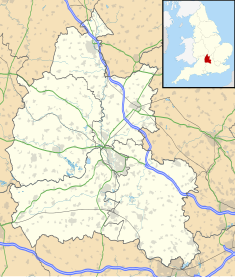Youlbury House
This article contains wording that promotes the subject in a subjective manner without imparting real information. (March 2024) |
| Youlbury House | |
|---|---|
 Youlbury House | |
| Location | Near Boars Hill, Oxfordshire |
| Coordinates | 51°43′29″N 1°18′21″W / 51.7246016°N 1.3058583°W |
| Built | 1969–1971 |
| Architect | Hal Moggridge |
| Architectural style(s) | Modernist |
Listed Building – Grade II | |
| Official name | Youlbury House |
| Reference no. | 1393396 |
Youlbury House is a Grade II listed modernist house located in the Youlbury Woods, near the Youlbury Scout Activity Centre and Boars Hill in Oxfordshire, United Kingdom.[1] The house was designed by Hal Moggridge and constructed between 1969 and 1971 for Lord Goodhart (William Goodhart QC). It incorporates historical elements of the original Victorian garden created by archaeologist Sir Arthur Evans.[2]
History
[edit]Original Victorian house
[edit]The original house, initially just called Youlbury,[3] dated back to the Victorian era (1830s-1900s). It was built in 1893 by Sir Arthur Evans for his wife Margaret, daughter of E. A. Freeman. Margaret died that year, but he went ahead with the house plans. Evans created the landscape gardens, the artificial lakes with the bathing huts and a waterlogged punt, as well as the house and its viewing platforms over the Vale of the White Horse and Berkshire downs. The gardens had tangled paths overhung with pink and white rhododendrons under a canopy of oak and pine, Himalayan poppies or the strawberry tree, intended to show Evan's appreciation for the natural world.[4]
James Stewart Candy, who lived there as a child and later became Mayor of Abingdon-on-Thames, describes the house in his autobiography as containing many rooms, pictures, tapestries, a large library, twenty-two bedrooms, five bathrooms, and a Roman bath. Outside one of the bathrooms was the head and shoulder of a bear from the Carpathian Mountains that had attacked Sir Arthur's brother, Norman. The house had a small museum of Cretan and Stone Age artifacts as well as New Zealand jade ceremonial weapons.[5]
In November 1918, in the aftermath of World War I, Youlbury House became the site of a war memorial facing the Berkshire Downs.[6] A path known as the Peace Path was constructed leading to the memorial. The path was distinguished by two scarlet oaks, planted to be symbolic of peace.
Youlbury House hosted guests of political and societal influence, among them Gilbert Murray, a founder of the League of Nations, and Lord Baden Powell, who visited and endorsed the site as a new headquarters for the Scouts. This expansion was seen as necessary due to the original headquarters becoming insufficient for the growing movement.[6]
The grounds of Youlbury House included a tennis court and a croquet lawn.[6]
Evans resided at Youlbury House, except when in Knossos, and lived there until his death in 1941.
The new modernist house
[edit]After being requisitioned by the War Office in 1941 and sustaining damage during World War II, the original house was demolished in 1950. The land was later acquired by Arthur Lehman Goodhart, and a new Youlbury House was designed by Hal Moggridge as a holiday and weekend home at the request of William Goodhart QC, the son of jurist Arthur Lehman Goodhart.[7]
Architecture and design
[edit]Youlbury House uses modernist motifs, making use of clean lines and integrating with the natural landscape. The structure features concrete floors on precast columns and western red cedar cladding. The interior includes an angled central hallway, and a unique staircase designed to allow natural light to permeate the space.[8]
Grounds and gardens
[edit]The house is situated on 9.6 acres of land that includes features from the original Victorian garden, such as grown trees and rockeries. The gardens were designed to maintain a balance between cultivated spaces and the natural woodland environment.[7]
Designation and conservation
[edit]Listed as a Grade II building in 2009, Youlbury House is protected by law, ensuring the preservation of its architectural features and historical significance.[9]
Gallery
[edit]- A contrasting winter angle of Youlbury House.
- Aerial view of Youlbury House's modernist structure surrounded by dense woodland, with Oxford in the distance.
- The aged stone staircase adorned with eagle statues, remnants of the Victorian era garden at Youlbury House.
References
[edit]- ^ "YOULBURY HOUSE, Wootton - 1393396 | Historic England". historicengland.org.uk. Retrieved 17 December 2024.
- ^ WowHauser (23 October 2015). "On the market: 1970s Hal Moggridge-designed Youlbury House in Oxford, Oxfordshire". WowHaus. Retrieved 17 December 2024.
- ^ "Arthur Evans's Gardens". 21 August 2016. Retrieved 24 January 2024.
- ^ Candy, James S. (1984). A Tapestry of Life - An Autobiography. Braunton, Devon: Merlin Books Ltd. p. [iii]. ISBN 0-86303-188-9.
- ^ Candy, James S. (1984). A Tapestry of Life - An Autobiography. Braunton, Devon: Merlin Books Ltd. p. [15]. ISBN 0-86303-188-9.
- ^ a b c Candy, James S. (1984). A Tapestry of Life - An Autobiography. Braunton, Devon: Merlin Books Ltd. p. [33]. ISBN 0-86303-188-9.
- ^ a b "Youlbury House, Wootton, Oxfordshire". Retrieved 21 January 2024.
- ^ "Hal Moggridge-designed Youlbury House in Oxford, Oxfordshire". 23 October 2015. Retrieved 21 January 2024.
- ^ "List Entry Number 1393396". Retrieved 21 January 2024.
External links
[edit]- Historic England List Entry for Youlbury House
- WowHaus article on Youlbury House
- Flickr image depicting the view from the original Youlbury House


 French
French Deutsch
Deutsch


